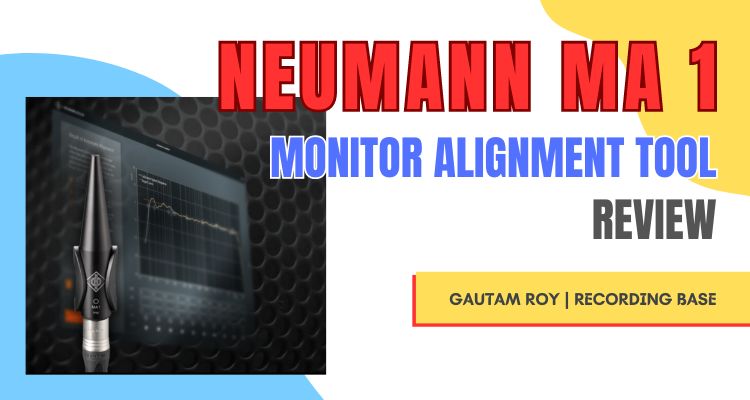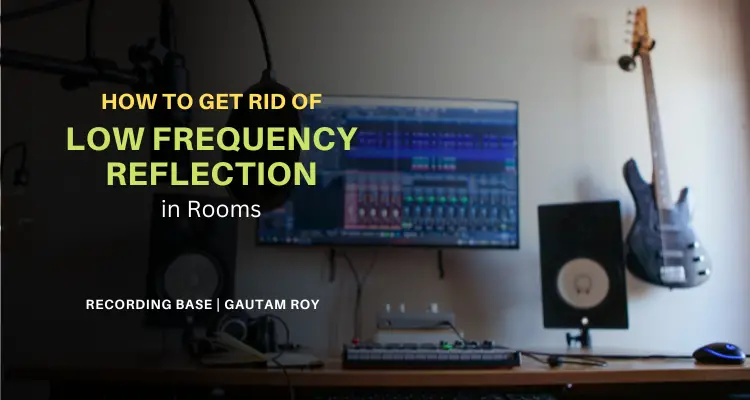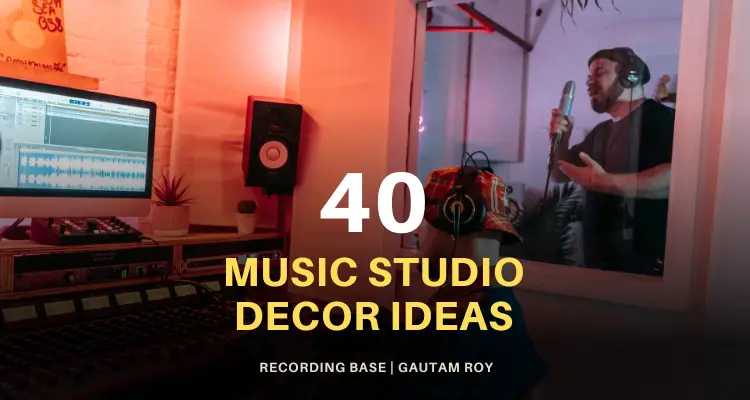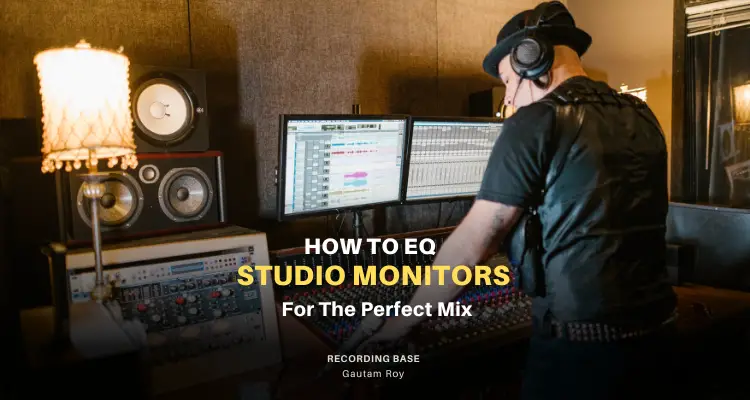This is the ultimate guide to choosing studio monitor cables for your home studio. Read this till the end to learn how to choose the right audio cables.
Studio monitors are one of the most important tools a recording engineer uses to record, mix and master audio.
We all are cautious about choosing the right studio monitors but we neglect to also choose the “RIGHT STUDIO MONITOR CABLES” which directly impacts the audio quality.
That’s why I thought to write this article, in which I have shared the top 10 monitor cables and also a monitor cables buying guide.
In this guide, you will learn about,
- Top 10 studio monitor cables available in the market
- How to choose the right studio monitor cables
- Features of all the monitor cables
- Types of monitor cables
- And some frequently asked questions
I have written a lot about studio monitors on Recording Base. Such as,
- Best Budget Studio Monitors For Home Studios [Ultimate List 2024]
- 5 Ways to Studio Monitor Isolation [Beginner’s Guide]
- 10 Best Studio Monitors Under $1000 [2024 List]
- Studio Monitors Vs Speakers | Difference Between Monitors and Speakers
BUT, when I dug deep into the world of studio monitor cables I saw, why people get confused in selecting the right ones. There are tons of monitor cables by different companies and different types of connectors available in the market. SO, getting confused is obvious.
WELL, this guide will definitely help you choose the best one so that you can get the best quality sound through your studio monitors.
Disclosure: This post may contain affiliate links, which means we may receive a commission if you click a link and purchase something that we recommended. Read more about Affiliate disclosure here.
During writing this article I have researched deep into the world of monitor cables, tested dozens of them, and then shortlisted 10 out of them to share with you.
Let’s have a look at the list after that we’ll learn the studio monitor cables buying guide.
Here is the list of what I have covered in this article,
Table of Contents
- 1 Top Picks
- 2 Studio Monitor Cable Buying Guide
- 3 Types of Studio Monitor audio cables
- 4 Types of audio cable connectors
- 5 How to Choose the Right Studio Monitor Cable
- 6 Top 10 Studio Monitor Cables For Home Studios
- 7 My Top 10 Studio Monitor Cables Reviewed
- 8 1. Сable Matters XLR
- 9 2. Mogami Gold Studio 15 XLR
- 10 3. Mogami GOLD RCA Cables
- 11 4. Monoprice RCA cable
- 12 5. GLS Audio TS Studio Monitor Cable
- 13 6. Monoprice XLR to TRS
- 14 7. TISINO TRS Cable
- 15 8. SEISMIC AUDIO – SATRX TRS
- 16 9. Hosa HSS-003 REAN TRS
- 17 10. Hosa CPR-202 Dual RCA to TRS
- 18 Conclusion
- 19 FAQs on Monitor Cables
Top Picks
| Cable Type | Product |
|---|---|
| XLR Connectors | Сable Matters XLR Male to Female Mogami Gold Studio Male to Female |
| RCA Connectors | Mogami GOLD RCA – Male to Male Monoprice 102864 – Male to Male |
| TS Connectors | GLS Audio Monitor Cable 15 ft unbalanced |
| XLR to TRS Connectors | Monoprice XLR to TRS 6 ft Balanced |
| TRS Connectors | TISINO TRS Cable 3 ft Male to Male Balanced SEISMIC AUDIO – SATRX 6 ft balanced Hosa HSS-003 REAN 3 ft balanced |
| RCA to TS Connectors | Hosa CPR-202 Dual Unbalanced 2 meters |
Studio Monitor Cable Buying Guide
The aim of this article is to help you choose a good studio monitor cable to get the best results out of it.
You might think that all studio monitor cables are the same but they are not. There is a number of factors that differentiate the cables as per the use and quality.
Some of these factors are,
- Variety of thicknesses
- Connection type
- Balanced or unbalanced
- Length
- Conductivity
- Interference shield quality
- Budget
We’ll discuss all of them below so that you can understand them and evaluate the cable you are going to buy as per these factors.
Types of Studio Monitor audio cables
In this section we will discuss, the various types of studio monitor cables as per connector types, balanced and unbalanced, analog and digital, etc.
First off,
Analog vs Digital Cables
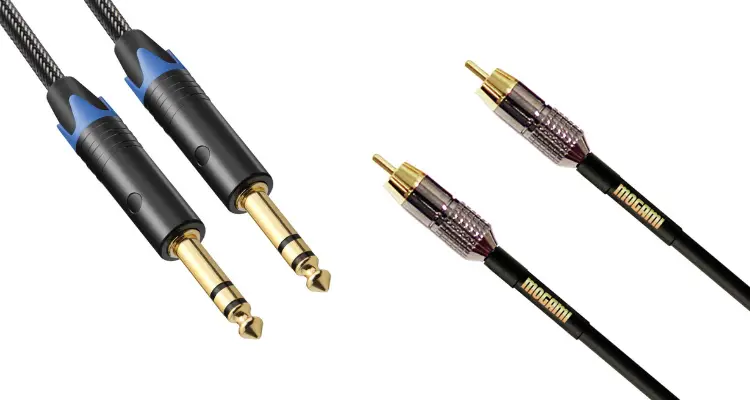
In this computer age, there are two types of cables out there.
Digital and Analog.
An Analog cable transfers the analog signal from one point to another whereas a digital cable transfers the digital signal (in Bytes).
The benefit of using digital cables is there is no signal loss in them. But, if you are using analog cables then some part of the signal gets lost in between the two points due to outer interference and the insulation of the cable material.
XLR, TS, TRS cables are pure analog cables while Optical, SPDIF cables are digital cables. Well, mostly analog cables are used to transmit signals in studio monitors. However, in some studio monitors, we can find the optical cable connector which is also good because there is no signal loss.
But, I prefer to choose a studio monitor with a balanced analog out. The reason is, analog transmission preserves the analog taste in the audio.
Now let me tell you the difference between balanced and unbalanced cables.
Balanced vs unbalanced cables
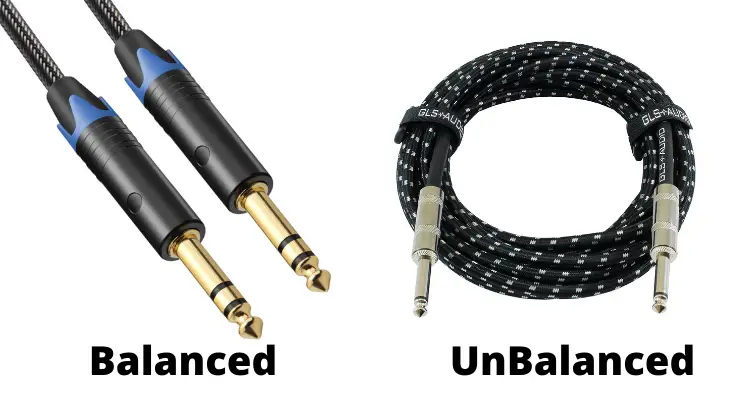
Balanced cables are made of three wires of which 2 wires are used to transmit the same audio signal but with reversed polarity and the third one is used for ground.
However, in classical wave theory, the same signal that arrives at the connection cancels out each of them which could leave you with silence. But the connection port has a mechanism to flip the inverted signal back into its original orientation.
This mechanism produces the original signal intact but the noise has reversed polarity and the resultant wave will be noise-free.
This arrangement gives you a noise-free sound and an extra 4 dB headroom in your mix. That’s why most studio monitors come with balanced cable connections.
On the opposite side, an unbalanced cable has only 2 wires of which one is the positive and the other is ground which carries the noise intact, and the result is the mix of audio signal and noise.
Types of audio cable connectors
Different studio monitors, audio interfaces, and mixers have different types of connections which include TS, TRS, XLR, RCA, Optical, etc.
In this section, I will show you the common connection types used in studio monitors so that you can find out your studio monitor’s connection type.
TS and TRS connectors
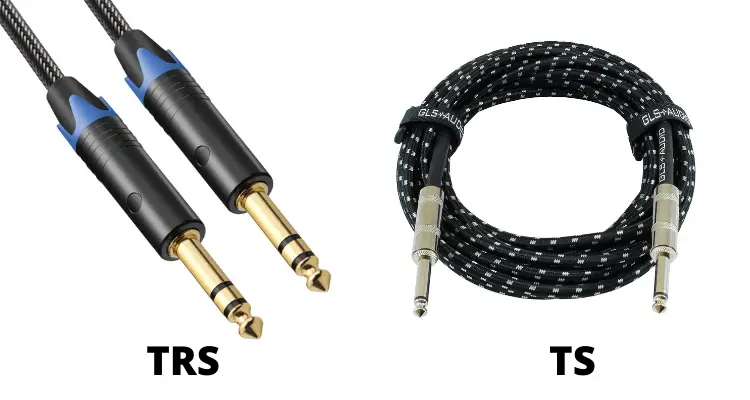
TS and TRS connectors are 1/4″ phono connectors where TS is an unbalanced connector and TRS is the balanced one.
Most mid-range studio monitors have a TRS connector type used to connect with the audio interface or mixer. As this is a balanced type connector, you have to buy a TRS cable to get the most benefit out of it.
The second type “TS” connector is the unbalanced version or TRS connector and it’s mostly used to connect analog instruments like guitars and basses.
Note: Maybe your studio monitor has a TRS connector and your audio interface has XLR or just the opposite. If this is the case then you should get a TRS-XLR cable. Also, you should check out if the XLR side has a female or male XLR connector. After checking out, you should get the TRS-XLR cable.
XLR Connectors
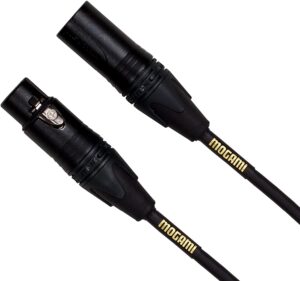
XLR connectors are balanced connectors that are mostly used to connect microphones, however, some high-end studio monitors have also this connector type.
XLR connectors transmit more clean signals than other connector types because of some reason. One reason is they fit well with the cable and thus are more conducive.
There are two types of XLR connectors, Male and Female. So, when you are using this connector, make sure the connector type if it’s male or female, and then order your cable.
RCA connectors
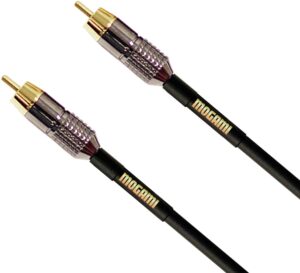
the worst type of connector in audio connections is RCA connector. This is the unbalanced connector type so if your studio monitor has this one, you will get the noise along with the audio signal.
So, I suggest my readers avoid those studio monitors and audio interfaces that come with only an RCA type of connector.
But, if you already have one and you want to get a cable for that then you need an RCA cable. But first, check out your audio interface’s output connector type if it has only TRS or XLR then you should get a TRS-RCA cable.
If your audio interface also has RCA output then you should get an RCA-RCA cable.
Bottom line: Always check the connection type on both your studio monitor and audio interface’s output and only after then order your cable accordingly. And, always try to use studio monitors and audio interfaces with balanced connection types.
How to Choose the Right Studio Monitor Cable
Now that you have the knowledge of all types of audio cables, it’s time to learn how to choose a suitable and good-quality studio monitor cable for your monitor.
In this section, we’ll discuss the 6 main factors that are used to choose tight studio monitor cables.
This first one is,
1. Cable Length
Cable length matters a lot. Whether you are choosing a guitar cable or an audio interface to a studio monitor cable, the first thing you have to decide is the minimum cable length.
If you do not consider the cable length you might end up with a short cable.
Remember, audio cables cannot be joined from the middle. unnecessary joints increase the outer interference thus low-quality audio.
On the other hand, if the cable is of more length than required, you will end up paying unnecessary costs.
So, first off, you should measure the length from your studio monitor to the audio interfaces and then order the appropriate length cable.
2. Variety of thicknesses
The thickness of an audio cable is inversely proportional to the outer interference. The more a cable is thick the less interference it catches. Which makes a cable quieter.
The thickness of a cable also improves its durability. That means the cable will last long.
So, always choose thick cables for audio recording purposes including studio monitor cables.
3. Connector type
As you have read about the various types of connectors, you already know you should choose the suitable connector types.
But, I want to add one more line here.
You should always go with balanced type connectors and cables if your monitor and audio interface supports it.
You already know the benefits of a balanced cable.
4. Conductivity
Do you know, conductivity increases and decreases as per the metal used in the wire? And, also the thickness of the wire.
So, I would suggest you use gold-plated connectors and copper wire cables. This will improve the conductivity of a cable and provide you with the best quality audio waves.
5. Interference Shield Quality
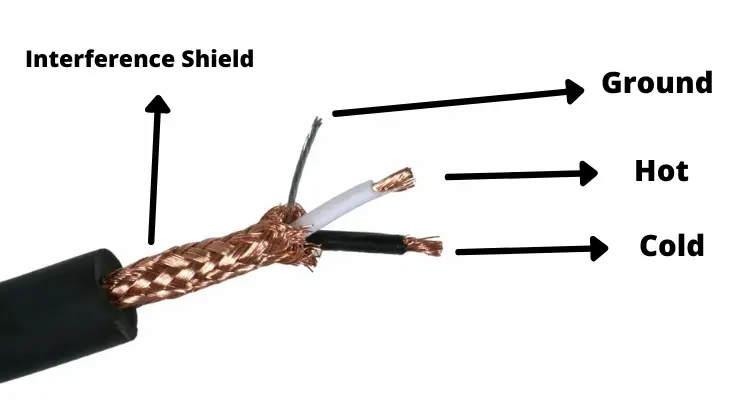
Almost all the audio cables have interference shields to protect the audio from outer interference which causes the noise.
An interference shield is a metal wire winding over the positive cable which replicates the outer magnetic field and electric waves.
Having a good-quality interference shield makes a cable quieter. So always choose the studio monitor cable having a good quality interference shield.
6. Your Budget
Last but not least, your budget matters.
All things stop on your budget. If you have a sufficient budget then you can go with premium cables but if your budget is limited then you have to choose an ordinary studio cable.
But, never choose an ordinary cable if you afford the better one.
Top 10 Studio Monitor Cables For Home Studios
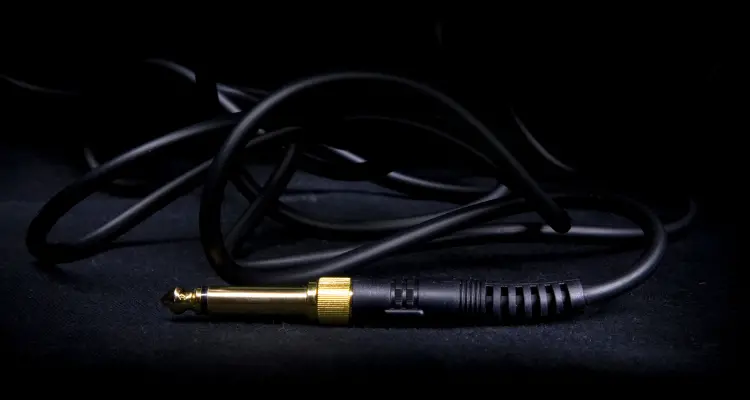
My Top 10 Studio Monitor Cables Reviewed
Apart from connecting studio monitors with audio interfaces, most of the studio monitor cables have multiple uses such as connecting instruments to audio interfaces and mixers, mixer to audio interface routing, etc.
So, getting more than one pair is a good idea for home studio owners.
Also, tag all your cables as per their use case, so that you can’t get confused.
Well, we’ll talk about it in detail in the upcoming sections. Let me first compare all the top 10 studio monitor cables for you.
1. Сable Matters XLR
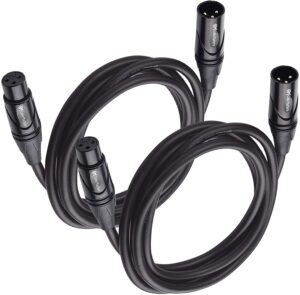
When it comes to recording studio connectors, XLR connector is the most common one. It is used for various applications from connecting microphones to the mixer or audio interfaces or connecting studio monitors.
Almost, all medium and high-range studio monitors have this connection. If you have this connection in your monitor then you should prefer this over others.
Cable Matters XLR cables are highly durable balanced XLR cables and go for years if handled correctly.
One good thing I have noticed, it comes in a dual pack which reduces your costs. The length(6 ft each) is sufficient to place studio monitors in a home studio.
I checked this on my Yamaha HS8 and got a clear sound. Maybe it’s because of its gold-plated connectors, low-impedance wires, and “balanced” feature.
In fact, I found it clear to put in the first place on my list. The best thing is, that you can also use this cable with your condenser mics where clarity matters a lot.
This is one of the best XLR cables on our list.
Features
- Best-in-class Gold plating on XLR connectors
- “Strain relief” pouched over the connectors
- Also compatible with DMX lights
- Oxygen-free copper (OFC) conductors for low impedance
- Individual wire insulation
- Available up to 35 feet in length
Pros
- Dual cable pack is cheaper than single cable packs
- Can be used with various applications including, studio monitors, Dynamic and condenser mics etc.
- Highly durable built
- Affordable pricing
Cons
- Only one color
Best Use
This cable is best used for studio monitor connections, dynamic, and condenser mics, and mixer routing.
Why Should You Choose This
There are multiple features that make it ideal for your needs. Such as Copper braided shielding which eliminates outer interference, oxygen-free copper (OFC) conductors for lower impedance, and availability in different lengths.
If you are searching for XLR monitor cables then I would highly recommend buying this one.
With that said, let’s have a look at my second recommendation.
2. Mogami Gold Studio 15 XLR

Mogami is a well-known name in the studio cable manufacturers. It has a wide range of recording studio cables.
Mogami Gold Studio 15 XLR is a high-quality XLR male to XLR female cable that can be used in various audio recording applications such as with mics and studio monitors.
It comes from 15 minimum 15 feet to 100 feet long sizes. You can choose yours as per your need.
This cable is made of Mogami Neglex Quad High Definition Microphone Cable which is a balanced 4-conductor cable that provides superior clarity and high noise cancellation.
Features
- Made of Mogami Neglex Quad High Definition Microphone Cable
- 15 to 100 feet sizes available
- Balanced 4-conductor cable
- Can be used with mixers, preamps, amplifiers, audio interfaces, loudspeakers, powered speakers, studio monitors etc.
Pros
- Enhanced dynamic range
- Excelant noise cancellation
Cons
- No color coding is available
Best Use
Best used with mixers, preamps, amplifiers, audio interfaces, loudspeakers, powered speakers, studio monitors, etc.
Why Should You Choose This
If you want high noise cancellation and crystal clear clarity in your sound then you should use this cable with your studio monitors as well as with other equipment.
3. Mogami GOLD RCA Cables

Do you have a monitor that supports only RCA input? Well don’t worry, Mogami Gold RCA will help you with this.
This is the superior quality RCA cable made especially for studio monitors. It is an unbalanced cable just like other RCA cables however, the low impedance and high conductor cables make it very clear to transfer the signals.
It is an excellent choice for audio, S/PDIF, and video signals, as well as your studio monitors that only support RCA inputs.
Pro tip: Along with the RCA connection, if your monitor has other connections such as XLR or TRS then prefer to use them over RCA because you will get the benefit of 4dB headroom due to balanced cable.
Features
- It is specially designed to use with S/PDIF, video signals, DJs and high-end consumer applications
- Available in 3 feet to 20 feet models
- Gold plated connectors
- Mogami’s signature shielding for a dead-silent background
Pros
- Dual gold contact RCA male plug connectors
- 75 Ohm Miniature Coaxial Audio/Video cable
- Magnetic shielding
Cons
- Unbalanced cable
- Available only up to 20 feet long
Best Use
Mogami Gold RCA is best used with S/PDIF, video signals, DJs, and high-end consumer applications.
Why Should You Choose This
Some low-end studio monitors come with unbalanced RCA connections. If your studio monitor has only RCA connectors then you should use Mogami Gold RCA to get the most out of your recordings.
4. Monoprice RCA cable
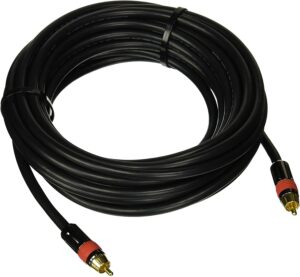
Monoprice is another well-known brand in the audio cables field. With its wide range of cables, it also builds RCA models.
This RCA cable is best for applications like S/PDIF, Digital Coax, Subwoofer and composite Video. Well, if your monitor has only RCA connections then this is a low-price solution to RCA cables.
You will get this cable for as low as $6 which is 6 feet long. The 75ohm impedance and thick magnetic shield make it an ideal cable for RCA studio monitors.
Features
- Very low 75ohm impedance
- Thick magnetic shield
- Gold plated connectors
Pros
- The gold-plated connectors, thick magnetic shield, and low impedance make it quiet.
- Low price
Cons
- Not as durable and clear as Mogami cables
- Available only up to 6 feet in size
Best Use
Monoprice RCA cable can be used in various applications such as S/PDIF, Digital Coax, Subwoofer and composite Video, and studio monitors.
Why Should You Choose This
If you are searching for a low-price but silent RCA studio monitor cable type then you should use this cable. Also if you don’t need a long cable and you can manage with up to 6 feet size then you should go with this cable.
5. GLS Audio TS Studio Monitor Cable
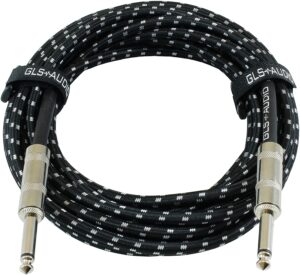
GLS Audio TS cable is an unbalanced TS audio cable that can be used for various tasks such as connecting studio monitors, guitars, and other instruments.
This cable is built with an OFC insulator shield & conductive PVC shield which makes it ultra-durable and minimizes interference. That results in high-quality audio.
This cable is available in different sizes between 10 ft to 15 ft.
Features
- Oxygen-free copper is used in both the center conductor and insulator shield
- OFC insulator shield & conductive PVC shield
- Flexible braided tweed jacket that coils neatly
- External & internal rubber heat shrink strain tubing makes it ultra-durable
Pros
- External & internal rubber heat shrink
- Oxygen-free copper
- Flexible braided tweed jacket
Cons
- Unbalanced cable
- Costly
Best Use
This cable is best used with guitars and other instruments, however, if you don’t want a balanced cable then you can choose it for your studio monitors.
Why Should You Choose This
The External & internal rubber heat shrink strain tubing gives it more durability than other cables. So, if you want durable cables then you should choose this.
6. Monoprice XLR to TRS
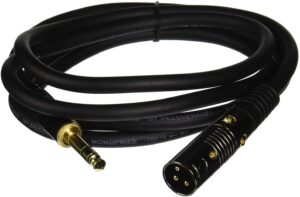
Monoprice XLR to TRS is one of the best cables available in the market for studio monitors. Most, of the Studio Monitors, feature XLR inputs whereas almost all the audio Interfaces come with balanced TRS outputs.
SO, this cable fits with almost all the audio interfaces and studio monitors.
Monoprice XLR to TRS cable features gold-plated connectors which ensures more conductivity. Also, this cable has a separate braided shield which provides additional resistance to interference.
Features
- Monoprice XLR to TRS is a balanced cable that gives you extra headroom in your mix.
- The separate braided shield provides extraordinary resistance to interference without modulating the interference with the signal.
- This cable works best with high-fidelity systems.
Pros
- Separate braided shield
- Gold plating
- Prevents ground loop issues
- Balanced cable
Cons
- Doesn’t work well with microphones
Best Use
It’s best used with studio monitors, instruments, etc for short distances.
Why Should You Choose This
The gold-plated connectors and balanced features make it ideal for studio monitors. So if you are searching for good studio monitor cables then this is built for you.
7. TISINO TRS Cable
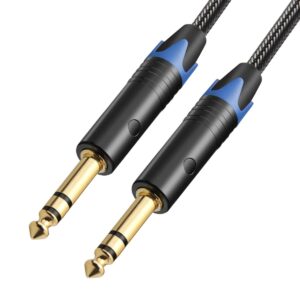
Ticino TRS cable is a highly durable 1/4″ phono male-to-male cable that can be used for various studio and stage applications including studio monitors.
Heavy Duty Gold-Plated Metal connectors are brilliant when it comes to conductivity. 20 AWG 4N Oxygen Free Copper with shielding makes it a high-fidelity sound cable and provides maximum conductivity with signal clarity.
It has a heavy Duty Flexible Rubber and Nylon Braid Jacket which ensures its strong, flexible, and durable performance.
Features
- 1/4 to 1/4 TRS male Cable
- Heavy Duty Gold-Plated connectors
- 20 AWG 4N Oxygen Free Copper with shielding
- Multiple layers of shielding and insulation
Pros
- Highly durable
- Balanced cable
- Oxygen-free copper built
Cons
- Costly than other cables
Best Use
This cable is best used for instruments, audio interfaces, and studio monitors.
Why Should You Choose This
If you are searching for a durable balanced phono cable for your studio monitor then this is the best fit for you.
8. SEISMIC AUDIO – SATRX TRS
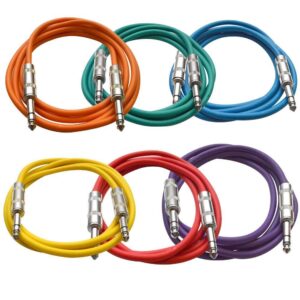
Seismic Audio SATRX TRS is another great studio monitor cable for those who want monitor cable at a cheap rate. It does not have gold-plated connectors, even you will get high-quality sound out of it.
Seismic Audio cables are available in multi-color 6 feet standard size. which is best if you want color coding in your cables.
Also, it comes in pairs so you don’t want separate ones for both your studio monitors.
Features
- Color-coded cables
- Comes in pair
- Best used to connect mixers to equalizers, crossovers, compressors, effects units, monitors, or amplifiers
Pros
- Color-coded cables
- Pair available
- One year warranty
- Balanced cable
Cons
- No Gold Plated connectors
Best Use
It’s best to connect mixers to equalizers, crossovers, compressors, effects units, monitors, or amplifiers.
Why Should You Choose This
If you want cheap balanced TRS cables for your studio monitors then you should choose this.
9. Hosa HSS-003 REAN TRS
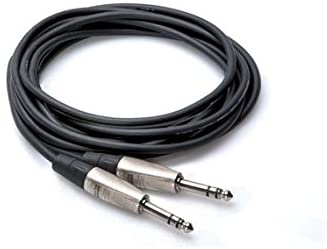
Hosa HSS-003 is a Nickel-plated highly durable TRS male-to-male cable that comes in different sizes from 3ft to 20 ft.
It has Oxygen-Free Copper (OFC) conductors which provide enhanced signal clarity. Also, the OFC spiral shield is very effective in EMI and RFI rejection and flexibility.
This is a balanced cable so you will get 4dB extra headroom in your mixes if you use them with your studio monitors
Features
- Nickel-plated REAN plugs
- Oxygen-Free Copper (OFC) conductors
- OFC spiral shield for effective EMI and RFI rejection
Pros
- Comes from 3 ft to 20 ft models
- Highly durable
Cons
- No gold plating
Best Use
Best used with guitars, studio monitors, audio interfaces, mixers, etc.
Why Should You Choose This
If you are searching for long cables for your studio monitor then you should choose it.
10. Hosa CPR-202 Dual RCA to TRS
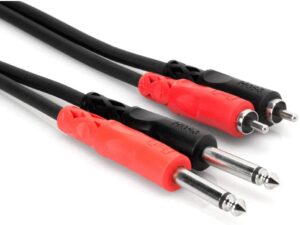
Do your studio monitors have an RCA connection while the audio interface has TRS connection? Well, if this is the case then you should choose Hosa CPR-202 Dual RCA to TRS cable.
Remember, RCA cable does not provide balanced output so you can’t get that 4dB extra headroom with them.
Hosa CPR-202 Dual is a cheap audio cable that is 6 meters long.
Features
- 6 Meters long
- Nickel-plated connectors
- Oxygen-Free Copper (OFC) conductors
- OFC spiral shields
Pros
- Best for ruff and tuff use
- Dual cable
- Oxygen-free copper (OFC) conductors provide better conductivity
- OFC spiral shields reduce interference and makes signal clear
Cons
- No gold plating
- No color coding
Best Use
Best used with Hi-Fi systems, studio monitors that support RCA connections, video connections, etc.
Why Should You Choose This
If your studio monitor supports only RCA connectors then you should use them.
Conclusion
Well, above you have learned all the aspects of a studio monitor cable from the top 10 studio monitor cables to choose your own set of cables.
Actually, I have added the “studio monitor cable buying guide” in this article because I cannot recommend any to you. the reason is all the monitors and audio interfaces are different so every person needs different studio monitor cables.
However, I have given the top 10 out of all the cables in the market which you can choose as per your need.
The buying guide will also help you to find suitable studio monitor cables for your studio.
Before ending this article, let’s get into some common FAQs from a common buyer.
FAQs on Monitor Cables
How to choose the best cables for studio monitors?
Well, read my guide above and you will be able to choose the right studio monitor cables. I have also given the top 10 cables as per the requirement that will help you to choose even better.
What cables do I need from the monitor to the output gear?
It depends on the connector type but I would suggest you always choose a balanced connector type and thick cable.
Why do people say XLR cables are better?
XLR cables are balanced cables so they are quieter than other cables.
Should I use balanced cables?
Definitely, if your studio monitor and audio interface have balanced output and inputs.
What are the different types of cable connectors?
XLR, TS, TRS, RCA, Optical are the common types of audio cable connectors.
Is XLR cable stereo?
No, however, XLR cables have three wires but they are not used as stereo cables. their wires are used to make a cable balanced.
What is the “polarity” in audio cables?
The angle of phase is called polarity. In audio cables, a change in polarity angle is used to make a cable balanced. I have discussed this concept above.
What are the differences between XLR, TRS/TRS cables?
The main difference is that an XLR cable has 3 wires inside while a TRS/TRS cable has 2 or 3. As mentioned earlier, the 3rd wire in an XLR is used for balanced audio while the 2 wires in a TRS/TRS are used for unbalanced audio.
Is there a difference between mic cables and instrument cables?
Yes, there is a difference between mic cables and instrument cables. Mic cables are typically used to connect microphones to audio equipment while instrument cables are used to connect instruments such as guitars and keyboards to audio equipment. Both of these types of cables can be either balanced or unbalanced, depending on the equipment they are connecting.
What is the difference between digital and analog audio cables?
Digital audio cables carry a digital signal while analog audio cables carry an analog signal. The type of cable you need will depend on the type of equipment you are connecting. For example, if you are connecting a digital audio source to an analog input, you will need an analog audio cable. On the other hand, if you are connecting an analog audio source to a digital input, you will need a digital audio cable.
What is the difference between shielded and unshielded cables?
Shielded cables have a layer of shielding around the signal wires, while unshielded cables do not. Shielding can help to reduce interference and improve the signal quality. However, unshielded cables are typically lighter and cheaper than shielded cables, making them a popular choice for many applications. Ultimately, the choice between shielded and unshielded cables will depend on your specific needs and preferences.
Related,

